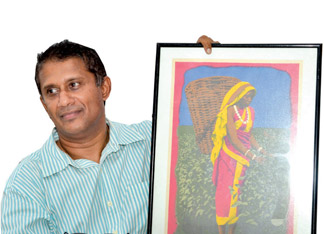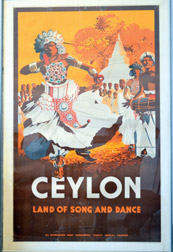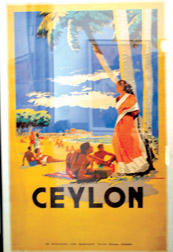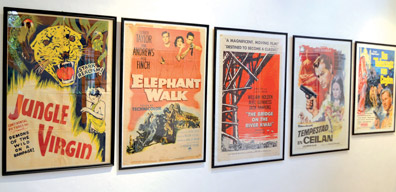Antiquity on paper
Ishara JAYAWARDANE
Anura Saparamadu stood before his posters at the Barefoot Gallery.
There was something romantic and sentimental about them. Maybe that is
because that epoch will never be seen again.
 |
|
Anura
Saparamadu. Pictures by Sarath Peiris |
 |
 |
|
Some of
Anura’s works |
There is a certain connection between Anura and his exhibition and
the rest of us who look at these posters. Anura who had this exhibition
displayed his sensitivity towards antiquity. And the posters evoke a
sense of nostalgia within all of us. So in short we all get to know the
canvasser and his work in a very intimate way. Each poster evoking
memories of a time and place. They were classic posters of Ceylon. This
exhibition featured posters of Ceylon dating back to a bygone era from
the late 1890’s to 1972. Among his posters were some movie posters such
as ‘Bridge on the River Kwai’.
Anura’s interest began on the internet when he saw his first Ceylon
poster. After that with much research he discovered that there were
hundreds and hundreds of posters about Ceylon. All this happened “it is
like works of art that was why I started collecting them and then I got
carried away and collected every poster related to Ceylon even if it is
not very nice artistically. Still if it related to Ceylon I will collect
them. My favorite is picking Tea Plucker Picking Empire Grown Tea.
(1929) I wrote a coffee table book about posters that was launched at
the Galle Lit Festival two years ago. This is the second exhibition. I
did this one at Barefoot because Dominic gave me the idea,” said Anura.
For Anura, if it is something to do with Ceylon he connects with it. “If
it is Sri Lanka before 1972, I would be interested in that.
But primarily I like the really old ones from an artistic point of
view. When you think about some of the best known designers, artists/
poster designers from that time in the 1930’s onwards until about the
1970’s tourist board and all the government officials and departments
would have poster design competitions and you get money and recognition
if your poster is the winner. There were some artists like G.S. Fernando
and C.K.L Samarasinghe who were amazing posters artists. In the 1930’s
and 1940’s they had these poster competitions till the 1970’s.
 The tourist board in 1948: the winning poster was Ceylon the Land of
Song and Dance. Incidentally I have got in touch with the families of
the artists.”A relentless gold digger when it comes to finding posters,
Anura mainly finds them through his dealers. “So when there is a new
poster available they get back to me. Sometimes I discover them on
internet and E Bay. Occasionally you find them in corners no one is
interested in them. And in America and England they have these
specialized poster dealers. I have received the most number of posters
from England. Among my most valuable posters is Land of Song and Dance
which is 3000 dollars. Some posters I buy for two three dollars. Some of
them are couple of hundred dollars. The most I’ve spent on is 1000
dollars. You always keep on finding new things that you never knew
existed. The tourist board in 1948: the winning poster was Ceylon the Land of
Song and Dance. Incidentally I have got in touch with the families of
the artists.”A relentless gold digger when it comes to finding posters,
Anura mainly finds them through his dealers. “So when there is a new
poster available they get back to me. Sometimes I discover them on
internet and E Bay. Occasionally you find them in corners no one is
interested in them. And in America and England they have these
specialized poster dealers. I have received the most number of posters
from England. Among my most valuable posters is Land of Song and Dance
which is 3000 dollars. Some posters I buy for two three dollars. Some of
them are couple of hundred dollars. The most I’ve spent on is 1000
dollars. You always keep on finding new things that you never knew
existed.
There are so many posters out there. The World War II posters that I
got were from the Imperial War Museum in England they have a huge
collection like hundred posters. So I got the rights to publish them in
the book. When doing the book it took me one year to do the research and
find out who the artists are. I only collect posters before 1972. So
basically everything is over 40 years old. You can also see how the
styles have changed over the years. The best posters in my opinion are
before the 1950’s. a lot of people don’t know these posters exist. When
they see them they are astounded. 80 – 90 percent of the posters are no
more because they are thrown out. All the time I get people telling me :
‘oh I remember this poster!,
‘I went to a rest house and remember this poster!’, ‘I remember all
those war posters!, ‘I had no idea there were such beautiful pictures of
ceylon’. And unfortunately the movie theatres have thrown out all their
posters. Some People have no idea that some of these attractive posters
were done by Sri Lankans.
Anura earns his bread and butter, where he does his own business
teaching English on the internet.
|





